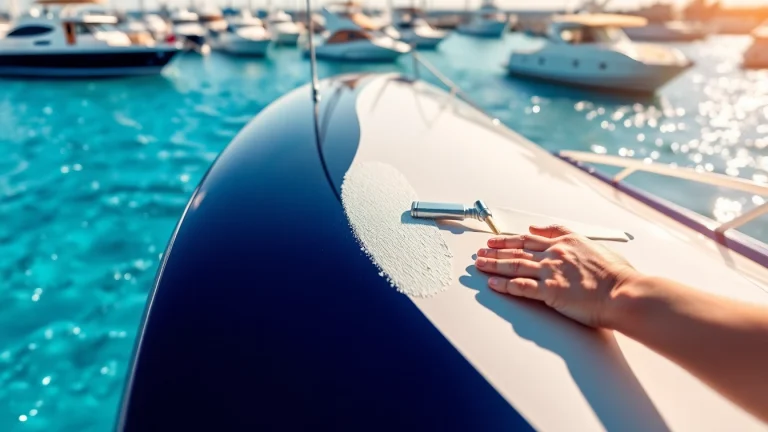
Elevate Your Vessel’s Protection with Marine Ceramic Coating
Understanding Marine Ceramic Coating
The marine industry has seen incredible innovation over the past few years, with the introduction of advanced protective solutions for vessels. Among these innovations, Marine Ceramic Coating stands out as a groundbreaking technology designed to enhance the longevity and performance of boats and yachts. This article dives deep into understanding marine ceramic coating, its benefits, applications, and maintenance to help you make informed decisions for your marine asset.
What is Marine Ceramic Coating?
Marine ceramic coating is a protective layer formed through the application of a ceramic polymer technology. This coating bonds with the surface of the vessel—commonly fiberglass, metal, or wood—providing a durable shield against environmental factors such as saltwater, UV rays, and abrasion. Unlike traditional wax or sealants, marine ceramic coatings offer superior hardness and resistance, ensuring your vessel maintains its aesthetic appeal while providing enhanced protection against wear and tear.
Benefits of Using Marine Ceramic Coating
The advantages of applying marine ceramic coatings to your boat or yacht are multifold:
- Durability: Marine ceramic coatings are resistant to scratches, chemicals, and pollutants, extending the lifespan of your vessel’s surface.
- UV Protection: The coating shields against harmful UV rays, preventing oxidation and fading, thus preserving the vessel’s color vibrancy.
- Easier Maintenance: The smooth surface created by the coating repels dirt, grime, and stains, meaning cleaning is less frequent and more efficient.
- Enhanced Hydrophobic Properties: Marine ceramic coatings allow water to bead up and roll away, improving the effectiveness of hull cleaning and reducing the buildup of marine growth.
Common Applications for Marine Ceramic Coating
Marine ceramic coatings can be applied to various surfaces and components of a vessel:
- Hull: Coating the hull of the boat protects against waterline stains and the harsh marine environment.
- Deck: Provides a non-slip surface that is easy to clean and resistant to UV damage.
- Metal Components: Protects fixtures and hardware from rust and corrosion.
- Glass and Plastics: Enhances clarity on windshields and other clear surfaces while offering protection from scratches.
How Marine Ceramic Coating Works
Key Ingredients in Marine Ceramic Coating
Marine ceramic coatings are made from a combination of silica and other ceramic nanoparticles, which are responsible for their exceptional durability and hydrophobic characteristics. These microparticles bond at a molecular level to create a protective shield that is far superior to conventional paint or wax.
The Science Behind the Protection
When applied, marine ceramic coatings undergo a process called curing. This involves the hardening of the coating through chemical reactions, which forms a cross-linked structure. This hardened layer acts as a barrier to environmental factors and significantly enhances the resistance to scratches, chemicals, and UV degradation. This scientific approach results in a coating that not only protects but also enhances the performance of the marine vessel.
Application Process Explained
The application of marine ceramic coating requires precision for optimal results. Here’s a step-by-step overview of the process:
- Surface Preparation: Thorough cleaning and decontamination of the surface to remove grime, old wax, or other residues.
- Polishing: Buffing the surface to a high gloss to ensure a perfect bond between the coating and the vessel’s surface.
- Application: The ceramic coating is applied in thin layers, allowing each layer to cure before applying the next for maximum protection.
- Curing: The final step involves allowing the coating to cure fully, which can take from several hours to a few days, depending on conditions.
Comparing Marine Ceramic Coating to Traditional Coatings
Durability and Longevity
When comparing marine ceramic coatings to traditional waxes or sealants, the differences in durability are striking. While traditional options may last a few weeks to a few months, marine ceramic coatings can provide protection that lasts for several years. This longevity means fewer applications required, saving both time and money.
Maintenance Requirements
Maintenance with traditional coatings involves frequent reapplication and intensive cleaning routines. In contrast, a vessel coated with marine ceramic requires significantly less upkeep due to its hydrophobic properties that repel dirt and grime. Routine washing becomes simpler and less labor-intensive, making the maintenance of your marine craft much easier.
Cost-Benefit Analysis
While the initial cost of marine ceramic coatings may be higher than traditional alternatives, the long-term benefits can significantly outweigh this initial investment. Considering the longevity, easier maintenance, and enhanced performance attributes, many vessel owners find marine ceramic coatings to be a cost-effective solution in the long run.
Choosing the Right Marine Ceramic Coating
Evaluating Different Brands and Products
Not all marine ceramic coatings are created equal. When selecting a product, consider the following factors:
- Ingredient Quality: Higher quality coatings typically contain more silica and advanced polymers, offering better protection.
- Reputation: Look for brands with a proven track record and positive reviews from other boat owners.
- Warranty: A good warranty can give you an idea of manufacturers’ confidence in their products.
How to Select Based on Vessel Type
The right marine ceramic coating may vary based on the type of vessel you own. Consider the following:
- Powerboats: Require coatings that provide robust protection against speed-related impacts.
- Sailboats: Benefit from coatings that enhance hydrodynamics while offering UV protection.
- Commercial Vessels: May require industrial-strength coatings designed for heavy wear and environmental exposure.
Expert Recommendations
Consulting marine professionals—such as surveyors, yacht brokers, or seasoned boaters—can yield valuable insights into the best marine ceramic coating options for your specific needs. Their experience can help guide you toward the most suitable products and application methods.
Maintaining Your Marine Ceramic Coating
Cleaning and Care Practices
To ensure the longevity of your marine ceramic coating, adopt proper cleaning practices. Regularly wash your vessel with a pH-neutral soap and soft cloth or sponge. Avoid using abrasive cleaners as they can damage the protective surface. Additionally, using a rinseless wash can help maintain the gloss without unnecessary friction.
Signs It Needs Reapplication
Even the best coatings will eventually require reapplication. Look for these signs:
- Loss of hydrophobic properties—water does not bead up.
- Visible fading or discoloration.
- Increased dirt and grime buildup that is difficult to remove.
Extending the Life of Your Coating
To extend the life of your marine ceramic coating, consider periodic maintenance using specific maintenance sprays designed for ceramic coatings. These sprays help replenish the coating’s protective layer and maintain its hydrophobic properties. Additionally, ensuring that your vessel is stored in a shaded area when not in use can protect it from UV damage.


